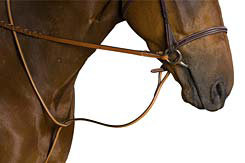This one I've put a lot of thought into and there's been all manner of discussion across the internet about various training aids, tools or what some would call gimmicks. Alright, here's my take. In the right hands, many of these things are indeed tools that help horsemen achieve their goals with their horses, but most can be improperly used and overused. Shortcuts are never okay. Choosing to use certain training tools while working toward an admirable goal is just fine in my book. But, there are some I simply don't have any use for.
Let's start with the basic running martingale ~ there are actually several variations, though I like to keep it simple. This is what I personally use:

Easy to adjust for each horse, no worries when properly adjusted of the horse coming into contact with it unless he's misbehaving.
Variations include the ten ring martingale (pictured below):

My problem with this one is fairly simple. A martingale should not be used as a leverage device and should only come into play if the horse attempts to throw his head in your face or otherwise try to get out of staying where he needs to be. With this one, there is too much of an ability to actually pull the horse's face down. Likewise with the training fork (pictured below):

I really dislike the training forks, even moreso than the "pleasure martingales", because of how easy they are to over-adjust. Pleasure martingale here:

Now, I've found these are almost always too long anyhow, unless your horse has the neck of a giraffe, and inevitably the rider has them tied in a knot. With my martingale of choice, no worries about that.
Let's move on to the standing martingale, which is not dissimilar to the tie down. Tie downs are used in working Western and Western games (roping, gymkhana, barrel racing) events and standing martingales are used in English circles for over-exuberant jumpers. What really is the difference, the English version attaches to the cavesson and because Western horses generally are ridden without a cavesson, tie downs come with a hanger and noseband in addition to the strap itself.
Standing martingale:

Tie down:

I've got a standing attachment for one breastplate I have and it's been used on one horse because I didn't want him to smash my face in. Never had any use for a tie down and here's why...that restriction of the horse and a desire not to impede his natural carriage and movement. Okay, ask any skilled roper and he'll tell you there is a need for a tie down in order to help the horse balance himself. I don't rope or game, thus reinforcing my not needing one.
Next up is the German martingale. There are really very few cases where I'll use one, such as the horse needing a little bit more help than a running martingale will give him, but not in need of draw reins (which I'll get to in a moment). Pictured here:

They work similarly to a cross between the two and work well for the horse who's learned to evade the bit while in draw reins.
Speaking of draw reins, they are basically a leverage device though I always use them in conjunction with a direct rein (as pictured in the first photo, below). There are as many configurations for draw reins as there are manufacturers, and they are used in both English and Western styles of riding.


I'm running out of steam ~ there is so much more I would have loved to cover and a whole lot more I wanted to say. Not being able to stay awake to write is becoming a severe hardship, however, so I'm going to wrap this one up. We will revisit the topic, get more in depth and explore things like chambons, sidechecks, overchecks and side reins later on.
Thanks for hanging in there!
~SFTS

I have to say, I have never owned any of those and most likely never will. When our trainer started the QH, we asked her to not use any type of tie-down because he carried his head level with his back and we were quite happy with that. She said she would never rely on a "crutch" like that anyway. We were his owners and that was fine with her. Back then; peanut rollers were still the rage and since Smoke was never destined to be a "pleasure" horse(tho' she said he was a pleasure to ride!), his natural head set was fine. I am not sure why one would need to tie a horse's head down; if he were trained, bitted, and not trying to evade the bit. Eh, what do I know, anyway. This is just my opinion.
ReplyDelete